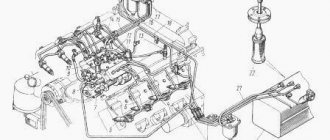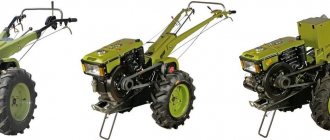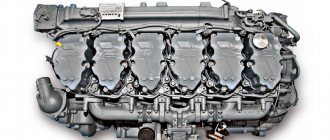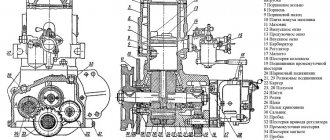The diesel engine, along with the gasoline engine, is one of the two most common types of reciprocating internal combustion engines. The principle of its work
It is based on the self-ignition of the air-fuel mixture, which is fed into the combustion chambers under pressure.
Due to this, the fuel heats up and spontaneously ignites, which is the main difference between a diesel engine and a gasoline engine and is the main reason for all design and operational changes in this type of power unit, and also directly affects the scope and frequency of its use. The article discusses in detail the history of the creation and improvement of a diesel engine, the device and principle of operation of such equipment, as well as its main differences and advantages compared to a gasoline power plant.
History of creation and improvement
The first scientific developments concerning the possibility of using fuel compressed to high pressure for ignition of fuel in a heat engine were carried out in the 20-30s of the 19th century. In practice, this principle was implemented by the outstanding German inventor and engineer Rudolf Diesel, who in 1892 filed a patent for the invention of an engine of an original design, called a diesel engine in honor of its creator. After 3 years, the document was recognized by the United States. Over the course of several years, Diesel registered several more patents for various modifications of the diesel engine.
The first working unit was manufactured at the end of 1896, and it was tested almost immediately - on January 28 of the following year. The first diesel engines used vegetable oils and light petroleum products as fuel. The power plant almost immediately began to show high efficiency, being also very easy to use. But in the first years after the invention, diesel engines were mainly used in heavy steam engines.
Significantly expand the scope of practical use of diesel units allowed two key improvements. The first was the use of kerosene as a fuel, which was first used in 1898 by another great engineer of the time, the Russian-born Swede Rudolf Nobel. The second major rationalization decision was the invention of a high-pressure fuel pump (TNVD), which replaced the compressor previously used to compress fuel.
A serious contribution to the improvement of high pressure fuel pumps was made in the 20s of the 20th century by Robert Bosch. He invented and introduced a model of an integrated pump and a compressorless nozzle, the use of which led to a significant reduction in the dimensions of the diesel engine, which, in turn, made it possible to install it first on public and freight transport, and in the second half of the 30s - for the first time to use it on cars machines. Further improvements to the unit under consideration, in particular the use of special diesel fuel, allowed the power plant on this type of fuel to successfully compete with gasoline engines, constantly increasing its market share.
Difference from gasoline engine
The main difference between a diesel engine and a gasoline engine was mentioned above. It consists in the absence of an ignition system, which is explained by the use of the principle of self-ignition of the fuel-air mixture as a result of pressurization and the resulting heating of the fuel. Several key consequences of the difference between the types of power plants under consideration should be noted.
The main positive points for the diesel engine are as follows. Firstly, the absence of an ignition system makes the design of the unit noticeably simpler, increasing reliability and durability. Secondly, compression ignition of the fuel provides more complete and efficient combustion, resulting in increased efficiency of the power plant and reduced emissions.
The main negative consequence of the above difference between internal combustion engines is more significant requirements for the strength and quality of manufacturing valves and other parts of diesel units. This is due to the fact that they are operated under a serious load associated with increased pressure of the fuel-air mixture.
How does a diesel engine work?
The principle of operation of a diesel engine is as follows: in the cylinder
clean air is sucked in when the piston moves down. And when you move the valve up, it heats up. It should be noted that the temperature during operation of a diesel engine can be from 700 to 900 °. This is achieved with strong compression. When the piston moves to top dead center, diesel fuel is injected into the combustion chamber at a sufficiently high pressure. When in contact with hot air, the fuel ignites. As a result, the pressure in the cylinder increases as the self-igniting fuel expands. This is what causes a lot of noise during operation of the unit.
Device
Both diesel and gasoline units are piston internal combustion engines, and therefore have a similar device. The main structural parts of a diesel power plant are as follows:
1. Cylinder block . The basis of any engine. Used to accommodate all systems and components of the power unit. They differ in three main parameters - the number of cylinders, their arrangement and the method of cooling. As a rule, the number of cylinders is even, their maximum number is 16. The most common engines are with 2nd, 4th, 6th or 8th cylinders.
An important element of the assembly under consideration is the so-called cylinder head or cylinder head. It creates an enclosed space in which direct combustion of the fuel mixture takes place.
2. Crank mechanism . The main purpose of this engine assembly is to convert the movement of the piston inside the sleeve, which is reciprocating, into the movement of the crankshaft, which is rotational. The main part of the mechanism is the crankshaft, movably connected to the cylinder block, which ensures the rotation of the shaft.
Another important detail is the flywheel, which is attached to one end of the crankshaft. Its task is to transmit torque to other components of the vehicle. A pulley and a drive gear of the fuel distribution system are attached to the second end of the crankshaft.
3. Cylinder piston group . Includes cylinders or liners, pistons or plungers, connecting rods and piston pins. Responsible for the process of fuel combustion with the subsequent transfer of the generated energy for further transformations. The combustion chamber is a space inside the sleeve, which is limited on the one hand by the cylinder head, and on the other by the piston. The main requirement for the cylinder-piston group of a diesel engine is tightness, strength and durability.
4. Fuel distribution system . The functional purpose is the timely supply of fuel to the combustion chambers and the removal of combustion products of the fuel-air mixture from the engine. In a diesel unit, the system is based on two pumps. The first of them - low pressure - is responsible for moving fuel from the tank to the engine.
The purpose of the second - high-pressure fuel pump - is somewhat wider and consists in determining the required amount and time of fuel injection, as well as in ensuring the required pressure level in the combustion chamber. It is the high pressure fuel pump and the injectors connected to it that are the key elements of the diesel engine, providing its impressive operational and technical parameters.
5. Lubrication system . Designed to reduce friction between individual components and parts of the power plant. As a lubricant, both various oils are used, and, which is typical for individual mechanisms, directly diesel fuel. The device of the lubrication system provides for the presence of an oil pump, various containers and connecting pipelines.
6. Cooling system . The main functional purpose of this element of a diesel engine is obvious and consists in maintaining a temperature level that is optimal for a running unit. Two methods are used for this - forced heat removal from engine components and cooling them with air or liquid. As the latter, water or antifreeze is usually used.
7. Additional components - turbine and intercooler . A turbocharger or turbocharger increases the pressure in the combustion chamber, which leads to an increase in engine performance. The intercooler is designed for additional and more efficient cooling of the hot air flow, which is created during the operation of the diesel unit.
Another important part of any modern diesel engine deserves special mention - electrical equipment and automation. It is the various control and monitoring devices for the operation of the unit that make it possible to achieve the main advantage characteristic of such power plants - high efficiency.
The design of the main components of diesel engines
A modern diesel engine is a complex unit consisting of a number of separate mechanisms, systems and devices. The design of a diesel engine depends on its purpose, power, application, etc. In any engine, the following main components can be distinguished: the frame, the crank mechanism, the gas distribution mechanism, and the purge and boost devices (Fig. 23).
The engine frame supports and guides moving parts, absorbs all efforts during engine operation; is a set of fixed engine parts - the foundation frame, crankcase, cylinders, cylinder covers, anchor ties, studs and bolts that tighten these parts.
The foundation frame is the base of the frame, designed for laying the crankshaft and serves as a container for collecting oil flowing from the engine lubrication units. The frame is loaded with the engine mass, gas pressure forces, inertia forces of translational motion and rotating masses; If the engine is equipped with attached mechanisms (water, oil, fuel priming pumps), then they are mounted on the front end of the frame; Frame bearings are a support for the crankshaft journals;
The crankcase serves to connect the cylinders to the foundation frame, forms a closed space for the placement of the crank mechanism (KShM). Crankcase parts are subjected to tension from the action of the maximum gas pressure force and compression by the preload force, as well as bending forces in crosshead engines;
The working cylinders are the part of the engine where the work cycle takes place. The cylinder consists of a jacket and a plug-in sleeve. The piston moves in the sleeve and work processes take place. The jacket is a support for the sleeve and forms cavities for its cooling. Cylinders are installed on the upper machined plane of the frame or crankcase and secured with studs or anchor ties.
The working cylinder cover closes and seals the working cylinder and forms the combustion chamber together with the piston and sleeve; the lid is subject to efforts from tightening the lid studs and variable gas pressure, as well as a high thermal load; two-stroke diesel covers have a simpler design due to the lack of valves;
The crank mechanism perceives the force from the gas pressure and converts the reciprocating movement of the piston into the rotational movement of the crankshaft. The main parts of the KShM in crosshead engines are the piston, piston rod, crosshead, connecting rod, crankshaft; in trunk engines - piston, piston pin, connecting rod, crankshaft.
The piston perceives the force of gas pressure and transmits it through the connecting rod to the crankshaft. In trunk engines, it acts as a slider, controls gas exchange in two-stroke diesel engines; The piston crown absorbs the pressure and heat of the hot gases, restricts and shapes the combustion chamber. The shape of the piston head depends on the mixture formation method used, the location of the combustion chamber and the type of scavenging. The piston is sealed in the cylinder by piston rings - compression and oil scraper. Compression rings seal the working gap, remove heat from the piston to the cylinder walls, oil scraper rings regulate the amount of oil, removing its excess from the cylinder mirror;
The connecting rod connects the piston or crosshead to the crankshaft, provides movement of the piston during auxiliary strokes; the connecting rod is subjected to the action of forces from the pressure of gases, the forces of inertia of translationally moving masses and the forces of inertia that arise when the connecting rod swings;
Crankshaft group - this includes the following engine components: crankshaft, counterweights, timing gear or sprocket, drive gears for mounted auxiliary mechanisms, axial fixation unit, damper, flywheel. The crankshaft is one of the most critical, stressful and expensive parts. When the engine is running, the shaft is loaded with gas pressure forces, inertia forces of reciprocating and rotating parts. To balance the centrifugal forces, the crankshafts are equipped with counterweights. If the auxiliary mechanisms that ensure the operation of the diesel engine are driven from the crankshaft of the engine itself, then the power is distributed to the mechanisms from the gearbox. Power take-off is made to gas distribution mechanisms, fuel, oil pumps and pumps of the cooling system. Flywheels are used to ensure uniform rotation of the engine crankshaft.
The gas distribution mechanism opens and closes the intake and exhaust organs in accordance with the accepted phases of gas exchange. The gas distribution mechanism consists of working valves and parts that transmit movement to them from the engine crankshaft - gears, camshafts, pushers, rods, levers. The design of the gas distribution mechanism depends on the design of the diesel engine itself. As a rule, the following types of gas distribution are used: valve, spool and combined.
Valve gas distribution is used in four-stroke diesel engines of all types and as a drive for exhaust valves in two-stroke diesel engines with a valve-slot gas exchange scheme (Fig. 24).
The top valves can be driven directly from the camshaft or through intermediate parts in the form of pushers, rods, rocker arms, levers, traverses. The location of the camshaft in this case can be either upper above the cylinder block cover (Fig. 24.a - d), or lower - along the cylinder block (Fig. 24.e). Top valves make it possible to obtain a compact combustion chamber of a cylindrical, conical or spherical shape, favorable for mixture formation and fuel combustion. Overhead valve arrangement is typical for various types of diesel engines. With the lower arrangement of the valves (Fig. 24.e), the arrangement of the cylinder head and the valve drive mechanism is simplified, the number of parts of the gas distribution mechanism and the height of the engine itself are reduced. In this case, the valves can be located both on one and on both sides of the cylinder block.
Spool (valveless) gas distribution is carried out by translationally moving or rotating spools, as well as spools that simultaneously perform translational and angular movements. With spool valve gas distribution, it is possible to ensure large flow sections for gases and silent operation of the engine. In two-stroke diesel engines, the piston itself and the windows in the cylinder bushings act as a spool pair.
Scavenging and supercharging devices for charging engine cylinders include: scavenging pumps (in two-stroke diesel engines), supercharging units, drive parts, scavenging and charge air receivers, air coolers, air filters.
Literature
Ship power plants. Diesel and gas turbine installations. Boldyrev O.N. [2003]
Similar articles
- Lubricating oils: physical and chemical properties
- Fuel: elemental composition of fuel
- The concept of diesel thermal balance: economic assessment
- Operation and power of engines: average indicated pressure
- Purge systems for two-stroke engines
- Working cycles of two-stroke engines
- Operating cycles of four-stroke engines
- Basic engine data: cylinder displacement
- Classification and marking of engines
- The principle of operation of engines: marine engine
Principle of operation
Diesel engines are divided into two-stroke and four-stroke. The first option in today's conditions is used extremely rarely, and therefore it simply does not make sense to consider it in detail. The standard principle of operation of a conventional four-stroke engine suggests, quite logically, 4 main stages:
1. Inlet . The crankshaft rotates between 0 and 180 degrees. At this stage, air is supplied to the cylinder.
2. Compression . The position of the crankshaft changes from 180 to 360 degrees. This ensures the movement of the piston to the so-called top dead center (TDC), which leads to compression of the air in the cylinder by 16-25 times.
3. Working stroke with subsequent expansion . The crankshaft moves between 360 and 540 degrees. Fuel is injected into the combustion chamber through nozzles, which, when mixed with air, ignites. This happens a little before the piston reaches TDC.
4. Release . The crankshaft completes a revolution by moving between 540 and 720 degrees. As a result of the next movement of the piston to the upper part of the cylinder, exhaust gases are removed from the combustion chamber. After that, the cycle starts anew.
resident Evil
Every five years, new environmental regulations are adopted in Europe. As luck would have it, the biggest tightening applies to those emissions that are more typical for diesel - we are talking about nitrogen oxides and particulate matter. From Euro-3 to Euro-6, the permissible level was reduced by eight and ten times, respectively.
Even with the normal combustion of diesel fuel, the formation of particulate matter - soot is inevitable. And there are plenty of modes of incomplete combustion, and in each soot emissions increase many times over. The notorious oxides of nitrogen are formed in the combustion chamber at high temperature and a large excess of air in the air-fuel mixture, on which, in fact, the diesel engine runs. Due to the same excess of air, the usual neutralizer is not able to neutralize them.
To begin with, engineers had to implement an exhaust gas recirculation (EGR) system that directs part of them back to the intake. Many people think that this is just for afterburning exhaust gases. Partly so, but the main task is to reduce the amount of oxygen in the fresh fuel-air mixture and bring down the combustion temperature in the cylinder. Sometimes gasoline engines are also equipped with a recirculation system. For a diesel engine, it consists of a control valve, a gas flow cooler and an inlet shut-off valve.
The EGR control valve is installed on the exhaust side and directs the exhaust gases (EG) back to the intake. Its work is managed by the engine control module. A position sensor is also built into the valve. A self-cleaning function is provided: when the engine is turned off, the valve opens and closes several times. If the EGR system fails, it remains closed. However, it is not uncommon for soot deposits and corrosion to cause the valve to stick open over time. The diesel engine does not differ in internal cleanliness, in addition, a full portion of the exhaust gas will constantly return to the intake, which will reduce the resource of engine elements and its power.
The EGR cooler works as an intercooler in pressurized systems. Cooled gases have a higher density and therefore require a higher flow rate. Additionally, they bring down the combustion temperature in the cylinder even more. In some engine modes, such intensive recirculation is harmful: it leads to incomplete combustion of the fuel - for example, during start-up and in warm-up mode. To avoid this, a valve is built into the system, which directs the gases around the cooler and additionally protects it from condensate deposition due to too low temperatures.
The intake shut-off valve is nothing more than a throttle valve that is located in the intake tract in front of the exhaust gas supply channel. If necessary, it closes almost half, reducing the cross-section of the inlet pipeline. This creates a vacuum in the intake manifold and increases the intensity of the exhaust gas recirculation. In fact, it is not used to operate the engine itself, except for the moment of its softer stop, when the damper closes completely and stops the air supply. The diesel engine has a high-quality regulation of the air-fuel mixture, that is, only the fuel injection parameters change. In case of failure, the damper is fully opened. The self-cleaning function is activated after the engine is switched off, when the throttle is fully opened and closed several times.
A malfunction of the exhaust gas recirculation system is signaled by the Check lamp. Diagnosis is carried out mainly with the help of a computer. The good health of the system and the engine itself will be extended by periodic trips out of town without traffic jams in order to slightly clean them of soot, as well as the use of recommended engine oil and refueling at proven gas stations. The combustion products of dubious diesel fuel and cheap oil will boomerang back into the engine.
Main varieties
The main parameter that is used to classify diesel engines is the design of the combustion chamber. According to this parameter, there are two main types of power plants under consideration, which use
· divided combustion chamber . Fuel is supplied to a special chamber, which is called a vortex chamber and is located in the block head, connecting to the cylinder using a channel. The presence of such an additional element makes it possible to achieve an increase in the level of injection, which has a positive effect on the ability of the mixture to self-ignite;
· undivided combustion chamber . A simpler and therefore more reliable design, when using which fuel is supplied directly to the space above the piston, which acts as a combustion chamber. This allows you to significantly reduce fuel consumption, which, along with the reliability of the mechanism, has become a key reason for the widespread use of this particular type of diesel engine.
Diesel units with an undivided combustion chamber became especially popular after the appearance of the Common Rail high-pressure fuel pump. Its use allows to provide the optimum level of pressure, quantity and time of fuel injection for subsequent combustion. Thus, all the main advantages of engines with a divided combustion chamber are achieved without their inherent disadvantages.
Types of diesel engines
There are several types of diesel engines. The difference is in the design of the combustion chamber. In diesel engines with an undivided combustion chamber - I call them diesel engines with direct injection - fuel is injected into the space above the piston, and the combustion chamber is made in the piston.
Direct injection is used on low-speed engines with large displacement. This is due to the difficulties of the combustion process, as well as increased noise and vibration. Thanks to the introduction of electronically controlled high-pressure fuel pumps (high pressure fuel pumps), two-stage fuel injection and optimization of the combustion process, it was possible to achieve stable operation of a diesel engine with an undivided combustion chamber at speeds up to 4500 rpm, improve efficiency, reduce noise and vibration. The most common is another type of diesel - with a separate combustion chamber . Fuel is injected not into the cylinder, but into an additional chamber. Typically, a swirl chamber is used, made in the cylinder head and connected to the cylinder by a special channel so that when compressed, the air entering the swirl chamber is intensively twisted, which improves the process of self-ignition and mixture formation. Self-ignition begins in the vortex chamber and then continues in the main combustion chamber.
With a separate combustion chamber, the rate of pressure increase in the cylinder is reduced, which helps to reduce noise and increase maximum speed. Such engines make up the majority of those installed on modern cars.











